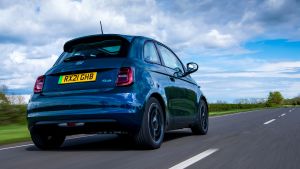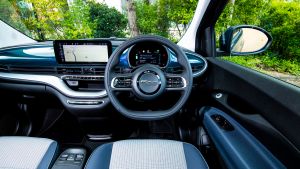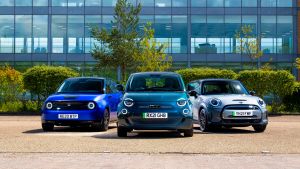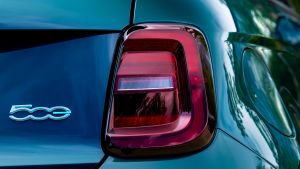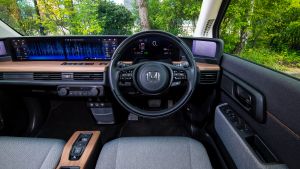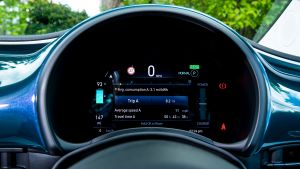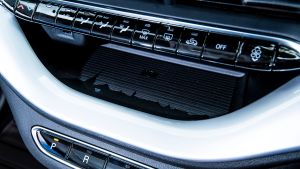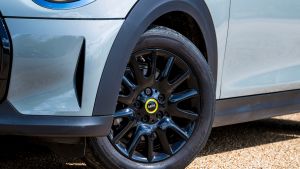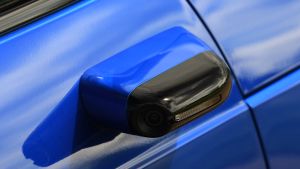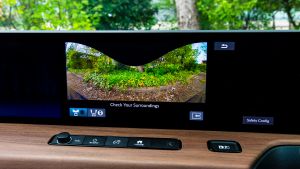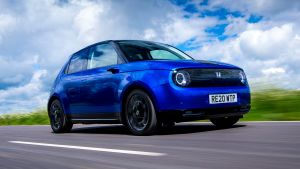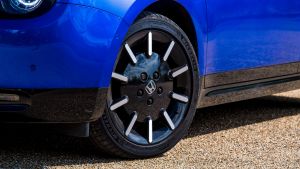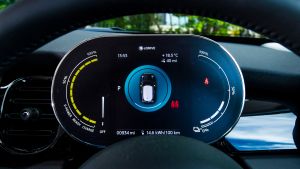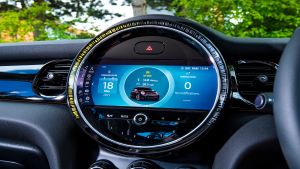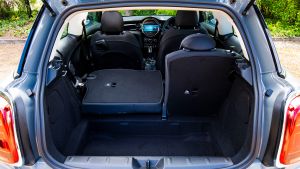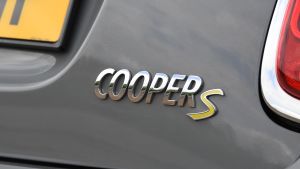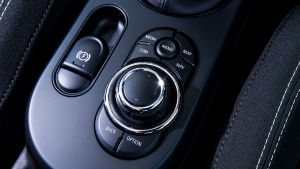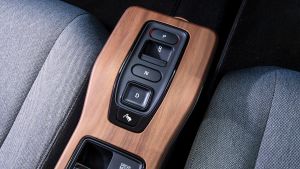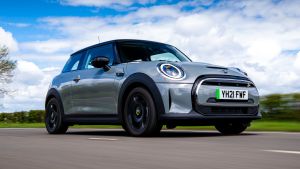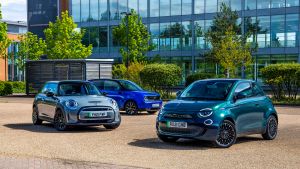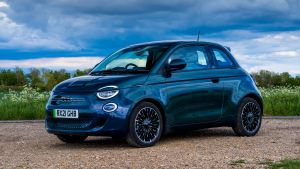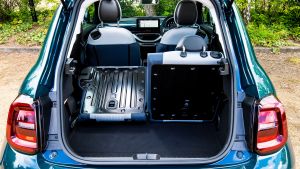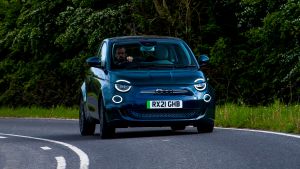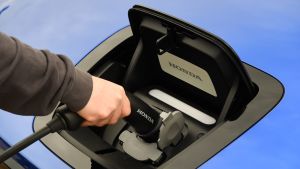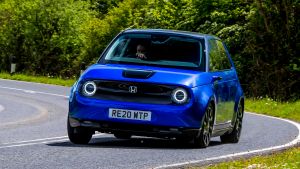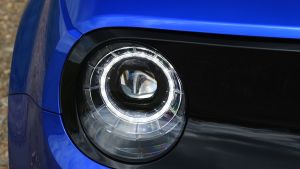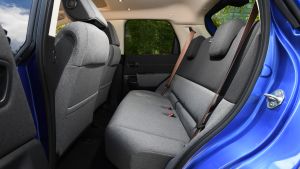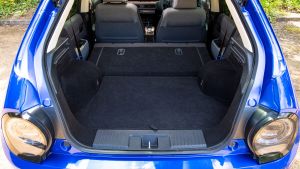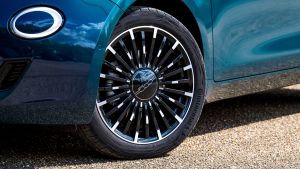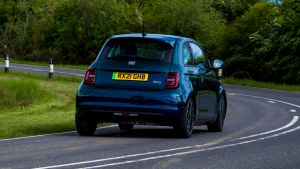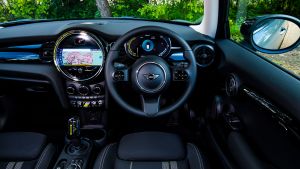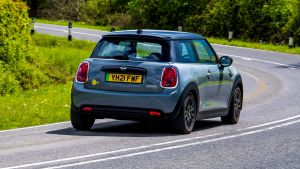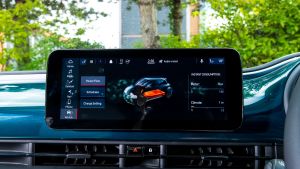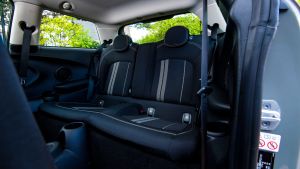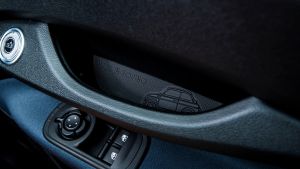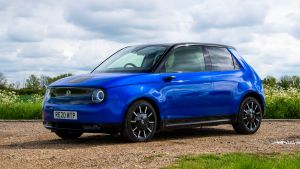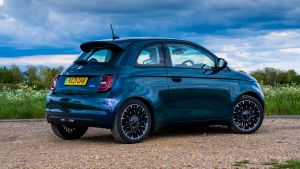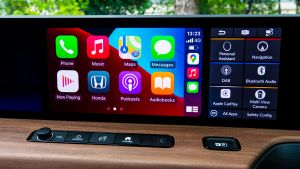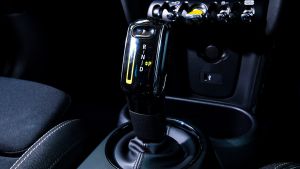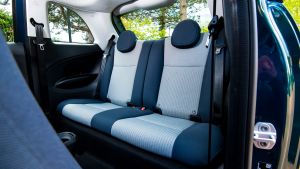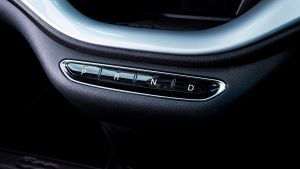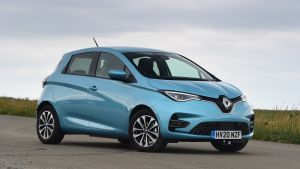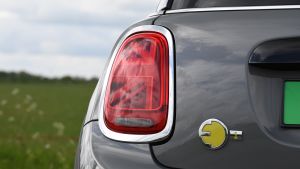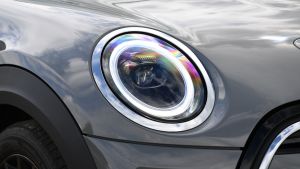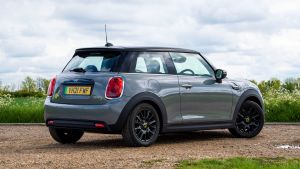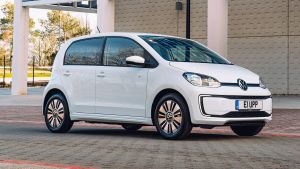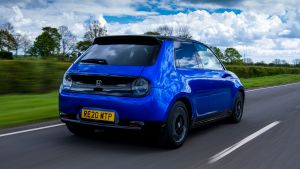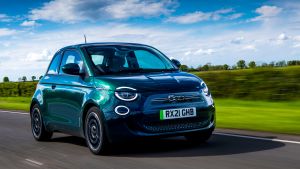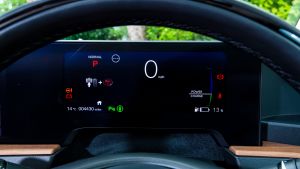Of all the parts of the new car market, the city car sector seems to be the best fit for electric drivetrains. Eliminating tailpipe emissions from the type of car designed for heavily populated urban environments seems like a no-brainer, but it’s not without its challenges.
Cramming in a battery with a usable range is no easy task, and when compared with an electric SUV or saloon, it’s arguably harder to make such a car affordable. It goes some way to explain why electric city cars such as the trio tested here justify their prices with premium equipment and quality.
- SEE MORE Best electric cars to buy 2021
The newest contender is the Fiat 500, and it’s really trying to challenge those hurdles. It has an impressively large battery, but not at an exorbitant cost. So does it feel as premium and as sophisticated to drive as its rivals?
The MINI Electric has been updated for 2021, with subtle styling revisions plus a refresh to the already-slick infotainment system. Here we’re testing it in its most basic trim; at £26,000 it’s the closest MINI can get to matching the Fiat 500 on price.
Pricier than both is the Honda e. A true concept car for the road, the Japanese city slicker boasts smart design and technology that few cars can match.
Fiat 500
| Model: | Fiat 500 Icon |
| Price: | £25,495 |
| Engine: | 1 x electric motor, 116bhp |
| 0-62mph: | 9.0 seconds |
| Test economy: | 4.0m/kWh |
| CO2: | 0g/km |
| Annual road tax: | £0 |
Fiat has brought its familiar city car icon into the era of electrification. Appropriately, the £25,495 model tested here is in Icon trim, although our test car is specced up with the best part of £4,000 worth of optional extras, including Level 2 Autonomous driving (£1,250), metallic paint (£600) and 17-inch alloy wheels (£500).
Design & engineering
It looks similar to the previous model, but the electric 500 is based on an entirely new platform in order to fit the powertrain. While it keeps the bubble-like shape, it’s 60mm longer and wider, and is 40mm taller than its petrol-powered sibling. Despite this growth, it’s still the smallest car here overall, at just 3.6 metres long.
There are interesting design details – the split headlights bring a contemporary look, while the sawtooth-shaped side repeaters add a modern twist to the semaphore signals fitted to the 1950s original.
Inside, the body-colored swipe across the dashboard is another nod to the classic, but that’s where the similarities end. The cabin is loaded with tech, including a 10.25-inch touchscreen, and a seven-inch digital driver’s display. In top-spec models, the Fiat is the first car in its class to offer Level 2 autonomous driving, which can accelerate, brake and steer the car to keep it in its lane.
The driver’s seat is set quite high, giving a good view of the road ahead. There’s no height adjustment, so some drivers might feel like they’re perched too high, but the steering wheel has a huge range of travel, which means that almost anyone should be able to get comfortable. Intrusion from the front wheelarch into the footwell means that the pedals are a little cramped and offset, though.
The 500 is available with two battery sizes, each of which is paired with a different electric motor mounted up front. All but the base model get the combination found here: a 134bhp motor with a 42kWh battery. That means the Fiat is the least powerful car here, but it also has the largest battery.
Driving
The 500 was designed with city driving in mind, and Fiat has done a solid job at making it easy to drive at low speeds. Those qualities are obvious even before you set off, because all-round visibility is the best here. It’s helped by that lofty driving position, but large windows with minimal blind spots help, as do all-round parking sensors and a reversing camera fitted to top trims.
Engaging drive or reverse is as simple as prodding big buttons on the dashboard, and once on the move – just like the other EVs here – the 500’s drivetrainis quiet and smooth, the latter aspect making it confidence-inspiring to shuffle the car around in traffic or when parking in a tight space. The turning circle is tighter than the MINI’s, although not as tight as the remarkable Honda’s.
Our test car was fitted with 17-inch wheels – a £500 option if you add them to Icon trim. We’d save the cash and stick with the 16-inch alloys – the larger rims make the car fidget a little too much over small bumps. At higher speeds, the ride is the softest here, and only a rustle of wind noise goes against what is otherwise a much better motorway cruiser than the car’s compact size suggests.
Practicality
All of these cars have four seats rather than five, and their tiny dimensions mean that, at best, all three feel rather cosy in the back. The Fiat is more than 200mm shorter than the already-compact MINI, and that’s most obvious in the rear, where things are very cramped. With the front seat set for a driver of average height, a rear-seat passenger of the same size will have their knees pressed firmly against the backrest ahead. The 500 also offers the least headroom of the three.
At 185 litres, the Fiat has more boot space than the Honda’s 171 litres, but less than the MINI’s 211-litre volume. The boot has a high lip, but there’s enough room to hide charging cables beneath a false floor. The rear seat backs split 50:50, but don’t fold flat.
Interior storage is good, if not quite as smartly designed as the cubbies in the Honda. Door bins are deep enough, there’s a central bin with a sliding cover, and the glovebox is larger than the MINI’s.
Ownership
The 500 is equipped with 85kW charging, which means that a 0-80 per cent top up of the battery takes just 35 minutes. While the MINI can also reach 80 per cent in that time, it’s a smaller battery; its 50kW charging rate adding fewer miles in the same period. The Honda’s 100kW system is slightly quicker, with an 80 per cent top-up taking 30 minutes.
The 500 has yet to be tested by Euro NCAP, but it comes with all of the latest tech, including autonomous emergency braking. An Isofix child seat point is available for the front passenger seat.
Running costs
Official WLTP figures state that the 500 will cover 199 miles on a single charge of the 42kWh battery. Our fully charged test car estimated a 168-mile range in Normal mode. Bump this up to Range mode and a couple of extra miles are added, and in Sherpa (which trims back the maximum power and limits top speed to 50mph) that figure increased to more than 180 miles.
Based on the 168-mile figure, the Fiat will cover four miles per kilowatt-hour used, compared with the Honda’s 3.8m/kWh and the MINI’s 3.6m/kWh. A driver doing 10,000 miles per year will spend £391 on charges on a home electricity tariff at 13p per kWh. That’s £20 less than the Honda and £42 less than the MINI. If you use public chargers, where the cost of energy could be three times greater, then the figures start to make a bigger difference.
Testers’ notes
“A small glowing button on the door is the 500’s electric door release. It’d be neat if it wasn’t for the fact the fail-safe levers are labelled in the door bins.”
MINI Electric
| Model: | MINI Electric Level 1 |
| Price: | £26,000 |
| Engine: | 1 x electric motor, 181bhp |
| 0-62mph: | 7.3 seconds |
| Test economy: | 3.6m/kWh |
| CO2: | 0g/km |
| Annual road tax: | £0 |
The refreshed MINI Electric range loses the Cooper S moniker from its title, but retains the same sporty performance. Here we’re driving it in its most basic Level 1 trim, which is priced from £26,000 including the £2,500 Government grant.
Design & engineering
Unlike the Fiat and the Honda, which have been developed from the ground up as electric vehicles, the MINI Electric uses an adapted version of the company’s petrol-powered platform. Despite this, there is little in the way of compromise that any owner will notice.
The electric model is 18mm taller than the standard three-door, because the ride height has been lifted to accommodate the battery, but interior space remains unaffected.
The battery pack is laid out in a T-shape, with the widest point beneath the rear seats. Combine this with an electric motor and control electronics set at the front, and the MINI Electric’s weight distribution is much more even than the petrol models, offering the potential for more secure (and fun) handing.
All three of these cars offer their own unique take on interior design, and they’re all the better for it. The MINI’s retro feel is highlighted by neat toggle switches for the ignition and drive mode switches, and the round bezel which houses the navigation system is a nod to the speedometer in the original.
The cabin also offers great perceived quality; it feels solid in a way that the other two can’t quite match. The revised 2021 model’s interior features some tweaks, including new steering-wheel mounted buttons. The piano-black finish looks neat, but the controls can be easily pressed by accident when holding the steering wheel in a 10-to-two position.
Digital dials are standard across the MINI Electric range. The small display adjusts with the steering column, so it’s always perfectly placed regardless of how you choose to sit.
Driving
If you’re searching for a small EV that can put a smile on your face, you can end your search here. The MINI Electric feels the most agile and playful car of this trio to drive, and has the best body control when driven enthusiastically.
Acceleration feels almost hot-hatch quick, too. The 0-62mph sprint takes 7.3 seconds – one second faster than the Honda, and a full 1.7 seconds ahead of the Fiat. Only the MINI’s numb steering lets the side down – although it is quick and responsive.
The MINI we tested had 16-inch wheels – not only the smallest available in the range, but also an inch smaller than those fitted to the Honda and Fiat tested here. Compared with our previous encounters with the MINI Electric and its rivals, this car’s larger tyre sidewalls really improve ride comfort at low speed. Where the Honda and Fiat fidget sightly, the smallest road imperfections are filtered out from the MINI’s cabin. Control is excellent, too – at higher speeds the MINI shrugs off undulations with sophistication.
However, the MINI is the least suited of this trio to town driving. Both the Honda and the Fiat have better turning circles, and this entry-level model doesn’t even come with a reversing camera or rear parking sensors, which is disappointing.
Practicality
Rear passengers will find the MINI more cramped than the Honda, but it’s more accommodating than the Fiat. Sculpted seat backs carve out a little more knee room for those in the rear, but adults will still find their shins resting against them. However, the rear seats are quite bolstered, so once you’re settled in them, they’re pretty comfortable and supportive.
Cubby spaces include a smartphone shelf that might struggle to hold the largest devices, door bins that are a little slim and a pair of fairly shallow cup-holders ahead of the drive selector.
Both the MINI and the Fiat locate their charge ports in the rear-three quarter panel – much like the fuel filler cap in most combustion-powered cars. The Honda’s is set in the centre of the bonnet, which means you don’t have to worry as much about which way to park when arriving at a charging point.
Ownership
At 50kW, the MINI offers the slowest charging system of the three cars here; the Fiat stretches to 85kW, and the Honda 100kW. A small battery means this isn’t a significant hardship, but it’ll add a few minutes to each stop – something that will crop up most often for MINI drivers, because it has the shortest real-world range of the three cars here.
As with the Fiat and the Honda, the MINI offers a three-year, unlimited-mileage warranty. A standard service plan is priced from £10 per month – this works out slightly cheaper than Honda’s £649 five-year package, which is £10.82 per month.
Running costs
While the MINI proved to be marginally the most expensive to recharge of the three, that’s not a huge surprise given that it also has the most power and the best straight-line performance.
However, something that really does stand in the MINI’s favour is depreciation. This Level 1 trim retains more than 57 per cent of its value after three years – that’s more than five per cent ahead of both the Fiat and the Honda, although the latter will be worth more, thanks to its higher list price. If you want to get near the Fiat’s level of equipment, you’ll need to spend more than £32,000 on a Level 3 model, which holds on to 55 per cent of its original price and be worth around £17k in three years.
With zero tailpipe emissions, all three of these cars will be extremely cheap for company car drivers. A lower-rate earner will pay £56 per year for the Fiat, £57 for the MINI, and £66 for the Honda.
Testers’ notes
“The MINI’s strongest level of braking resistance means it’s easy to drive the car using one pedal, but we wish there were more than two stages of energy recovery.”
Honda e
| Model: | Honda e Advance |
| Price: | £30,715 |
| Engine: | 1 x electric motor, 152bhp |
| 0-62mph: | 8.3 seconds |
| Test economy: | 3.8m/kWh |
| CO2: | 0g/km |
| Annual road tax: | £0 |
The Honda e has proved to be an utterly charming small EV on our previous encounters with it, and it has ability to back up its appeal. Will this Advance model, priced at £30,715 (but fitted with optional metallic paint here, at £550) hold its own against Fiat’s latest challenger?
Design & engineering
When the Honda Urban EV concept was revealed in 2017, many onlookers were blown away by the retro-futuristic design. Excitement grew further when Honda confirmed it would be going into production.
Although the showroom model was inevitably toned down from the show star – the wheels shrank, the slim roof pillars grew thicker and the body sprung an extra pair of doors – it still has concept car looks that draw lots of attention on the road.
Inside, the Honda e impresses just as much, with a design that is quite unlike anything else. The wood is fake, but it’s applied tastefully, while the rich fabric upholstery on the seats and the door trims (leather isn’t offered) feels expensive yet different.
A bank of five screens spans the dashboard, and the window line feels low, so the view out ahead is good. A benefit of the electric-specific platform is that the floor is completely flat, which helps the cabin to feel open and spacious. If there’s one slight criticism, it’s that the steering wheel reach adjustment doesn’t come out far enough for some.
Unlike the other two cars, the Honda’s motor is located at the back and drives the rear wheels. At 152bhp, it has 36bhp more than the Fiat’s and 29bhp less than the MINI’s. The power electronics are stored under the bonnet, while the 35.5kWh battery is under the floor and between the axles.
Driving
Few cars are so well suited to city car life as the Honda e. Those cameras in place of the regular mirrors play a part – they take a couple of inches off the car’s width so it’s easier to squeeze through gaps, but it’s the fantastic steering lock that really helps.
At 8.6 metres, the Honda’s turning circle is almost a match for a black cab, which makes the fact that it’s genuinely entertaining to hustle along a B-road all the more impressive. Grip is strong, and at motorway speeds the car feels stable. The ride is slightly firmer than the Fiat’s, but it does a great job of isolating suspension knocks and road noise from the cabin. However, it does get thrown off course by bumps ever so slightly more than the MINI.
All three cars have adjustable regeneration settings, and in truth none of them gets it quite right. The Honda does it best: four modes can be chosen via wheel-mounted paddles, which feels very intuitive, and there’s a separate button that allows you to select one-pedal driving, where you ease the accelerator to slow the car, rather than hitting the brakes. The 500 also caters for one-pedallers, but only in Range and Sherpa modes – leave the car in Normal, and the mild deceleration is similar to conventional engine braking.
The MINI is rather frustrating. Of the two modes available, the strongest gives very heavy regen, a mode it defaults to every time the car is switched on – we’d prefer it to stay in the mode last used.
Practicality
As the only car with five doors here, the Honda e chalks up a big advantage over the Fiat and MINI. Those back doors open to almost 90 degrees, and there’s roughly an inch more knee room than in the MINI, while headroom is roughly the same.
For a city car, storage is generous and well thought out. In the front there are three big cubbies in the centre console, a pull-out cup-holder and a neat pouch for a smartphone. Each rear seat passenger gets a small bottle holder in the doors.
However, the Honda also has to make do with the smallest boot of this trio. Even though the area is quite broad compared with the others, the high floor limits overall volume to just 171 litres. There’s no dedicated area to stow away the charging cables, either, so space is even more compromised. The rear seat back doesn’t split, but it does fold almost flat.
Ownership
Honda ranks very highly in our Driver Power satisfaction surveys. As a manufacturer it finished seventh out of the 30 brands surveyed, while its dealers were ranked second only to Lexus’. In comparison, MINI was a disappointing 26th as a brand while its dealers came 17th. Fiat’s cars ranked slightly better than MINI, with a 23rd place finish.
When the Honda e was safety tested by Euro NCAP in 2020, it scored four stars. The combustion-engined MINI achieved the same score in 2014, while the Fiat is yet to be tested.
Running costs
The optional 17-inch wheels on our test car were fitted with Michelin Pilot Sport 4 tyres, rubber that’s often used on performance cars, and while they deliver great grip, it comes at the cost of energy efficiency. Go for 16-inch wheels wrapped in eco-tyres, and you’ll likely improve energy consumption.
The tyres likely play a part in the reason why the Honda can’t quite match the Fiat when it comes to electrical efficiency. The 35.5kWh battery costs roughly £4.60 to top up on a standard energy tariff, enough for a real-world range of 108 miles. Given it has a larger battery, the Fiat will of course cost more to charge, at £5.46. However, that extra 86p will get you a full 60 miles farther. The MINI will cover 104 miles, with a home charge cost of £4.24.
A high group 29 insurance rating means that the Honda will cost more to cover than the Fiat, which falls into group 16. At group 21, the MINI’s costs should fall between the two.
Testers’ notes
“Honda e owners have many ways to pass the time while charging. An HDMI port and a three-pin plug socket make it possible to plug in a games console.”
Verdict
First place: Fiat 500
Fiat's new small EV has moved the game on. Not only does the 500 have all the style, appeal and tech of its city car rivals here, but it delivers a significantly better real-world range. That it wraps it all up in a package that’s brilliant value for money means the 500 deserves the win. This isn’t just one of the best small electric cars on sale today, it’s one of the best EVs you can buy, full stop.
Second place: Honda e
Approached purely as a city car, the Honda is still one of the best around. Its manoeuvrability is unmatched, yet it’s still surprisingly spacious inside. The head-turning looks and gorgeous cabin feel genuinely special, too. However, in this company, it’s too expensive to buy – especially when the Fiat offers much greater range for less cash.
Third place: MINI Electric
Buyers looking for a fun second car that has zero emissions will find the MINI Electric hard to fault. It feels as sporty to drive as any combustion-powered model in the brand’s line-up, and still looks great inside and out. However, meagre equipment levels and the least range here mean that it doesn’t feel like it offers good enough value for money when compared with its rivals.
Also consider...
Renault Zoe
- Model: Renault Zoe R135 Iconic
- Price: £30,095
- Powertrain: 52kWh/133bhp
In many ways, the Zoe delivers greater practicality than any of our test trio. A larger body means not only space for people and things (it’s a five-seater with a roomy 338-litre boot) but there’s space for a big battery that’s good for a 245-mile range.
Volkswagen e-Up!
- Model: Volkswagen e-Up!
- Price: £21,055
- Powertrain: 36.8kWh/81bhp
Volkswagen’s small electric car is the closest alternative to the Fiat for price and range. Indeed, the line-up starts from £21,055 – roughly the same as the 24kWh 500. Good though it is, it lacks the Fiat’s performance and refinement.
Figures
| Fiat 500 Icon | Honda e Advance | MINI Electric Level 1 | |
| On the road price/total as tested | £25,495/£29,325 | £30,715/£31,265 | £26,000/£26,000 |
| Residual value (after 3yrs/36,000) | £13,342/52% | £15,963/52% | £14,916/57% |
| Depreciation | £12,153 | £14,752 | £11,084 |
| Annual tax liability std/higher rate | £56/£112 | £66/£133 | £57/£114 |
| Annual elec. cost (12k/20k miles) | £391/£652 | £411/£684 | £433/£722 |
| Ins. group/quote/road tax cost | 16/£328/£0 | 29/£452/£0 | 21/N/A/£0 |
| Servicing costs | TBC | £649 (5 years) | £10 per month |
| Length/wheelbase | 3,632/2,322mm | 3,894/2,538mm | 3,845/2,495mm |
| Height/width | 1,527/1,900*mm | 1,512/1,752mm | 1,432/1,727mm |
| Powertrain | 1x motor/li-ion battery | 1x motor/li-ion battery | 1 x motor/li-ion battery |
| Peak power | 116bhp | 152bhp | 181bhp |
| Peak torque | 220Nm | 315Nm | 270Nm |
| Transmission | single-speed/fwd | Single-speed/rwd | Single-speed/fwd |
| Battery capacity/usable | 42/42 kWh | 35.5/28.5 kWh | 32.6/28.9 kWh |
| Boot capacity (seats up/down) | 185/550 litres | 171/861 litres | 211/731 litres |
| Kerbweight/payload | 1,365/400kg | 1,543/350kg | 1,365/405kg |
| Turning circle | 9.7 metres | 8.6 metres | 10.7 metres |
| Basic warranty/recovery | 3yrs (unlimited)/1yr | 3yrs (unlimited)/3yrs | 3yrs (unlimited)/3yrs |
| Driver Power manufacturer/dealer pos | 23rd/N/A | 7th/2nd | 26th/17th |
| NCAP: Adult/child/ped./assist/stars | N/A | 76/82/62/65/4 | 79/73/66/56/4 |
| 0-62mph/top speed | 9.0 secs/93mph (ltd) | 8.3 secs/90mph | 7.3 secs/93mph |
| Auto Express econ/predicted range | 4.0m/kWh/168 mile | 3.8m/kWh/108 miles | 3.6m/kWh/104 miles |
| Claimed range (WLTP) | 199 miles | 137 miles | 145 miles |
| Charging capability | 2.3/11/85kW | 2.3/7.4/50/100kW | 2.3/7.4/11/50kW |
| Charging time | 15h 15m/4h 15m/35m | 18h 48m/4h 6m/31m/30m | 12h/3h 12m/2h 30m/36m |
| Actual/claimed CO2/tax bracket | 0/0g/km/1% | 0/0g/km/1% | 0/0g/km/1% |
| Airbags/Isofix/park sensors/camera | Six/yes/rear/yes | Six/yes/yes/yes | Six/yes/no/no |
| Auto/lane keep/blind spot/AEB | Yes/yes/£850**/yes | Yes/yes/yes/yes | Yes/no/no/yes |
| Climate/cruise/leather/heated seats | Yes/yes/no/£450+ | Yes/adaptive/no/yes | Yes/yes/no/no |
| Met paint/LEDs/keyless/pwr tailgate | £600/£850^/yes/no | £550/yes/yes/no | £0/yes/yes/no |
| Sat-nav/digi dash/DAB/connectivity | Yes/yes/yes/yes | Yes/yes/yes/yes | Yes/yes/yes/yes |
| Wireless charge/CarPlay/Android Auto | £130/yes/yes | No/yes/yes | No/yes/no |
